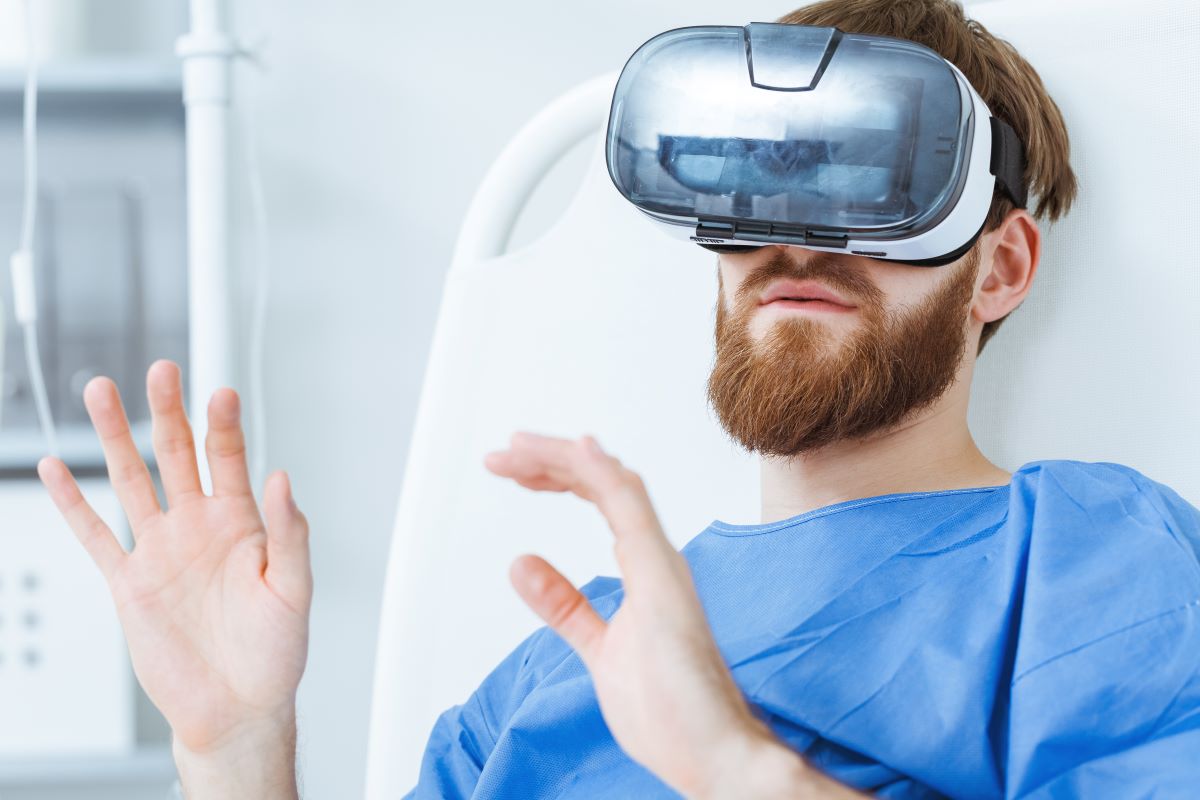In recent years, virtual reality (VR) has emerged as a transformative technology in the healthcare industry, offering innovative solutions that enhance patient care, medical training, and therapeutic interventions. As we delve into the future of healthcare, it’s crucial to explore the potential and progress of virtual reality in reshaping the landscape of digital health.
Let’s take a closer look at how VR is making significant strides in revolutionizing healthcare.
Enhanced Medical Training
Virtual reality has become a cornerstone in modern medical education. Traditionally, medical students learned through textbooks, lectures, and observing surgeries from a distance. However, VR has changed the game by offering immersive, hands-on training experiences. Medical students can now step into a virtual operating room, pick up surgical tools, and practice procedures as many times as needed. This not only accelerates the learning curve but also fosters confidence and competence among future healthcare professionals.
Moreover, VR facilitates collaborative learning. Medical students and professionals from around the world can join virtual simulations, allowing for cross-border knowledge sharing and enhancing the diversity of experiences. The ability to recreate rare or complex cases in VR also enables medical teams to prepare for surgeries with precision, reducing risks and complications in real-life procedures.
Pain Management and Therapy
In healthcare, the battle against pain is ongoing. Virtual reality has emerged as a powerful adjunct in pain management and therapy. By immersing patients in calming, distraction-rich virtual environments, the brain’s focus shifts away from the sensation of pain. This technology is particularly beneficial for pediatric patients who may find traditional pain management techniques distressing.
VR therapy is also making strides in mental health. Patients with anxiety disorders, post-traumatic stress disorder (PTSD), or even depression can benefit from exposure therapy in VR. Therapists can carefully control and customize the virtual scenarios to suit each patient’s needs, gradually desensitizing them to their triggers. This personalized approach enhances the effectiveness of therapy and improves patients’ overall quality of life.
Phobia Treatment
Phobias can significantly impact a person’s life, often leading to avoidance behaviors and reduced quality of life. VR is changing the game in phobia treatment by offering a controlled and immersive exposure therapy environment. For example, a person with a fear of flying can gradually expose themselves to the experience through VR flights, with therapists guiding them through the process.
The immersive nature of VR helps patients confront their fears in a safe and gradual manner, reducing the emotional distress associated with traditional exposure therapy. Over time, patients often experience a reduction in anxiety and an increased ability to cope with the situations that once triggered their phobias. VR-based exposure therapy is revolutionizing the treatment of conditions like arachnophobia, agoraphobia, and social anxiety.
Remote Consultations and Telemedicine
Virtual reality is poised to take telemedicine to new heights. While video calls have been the primary mode of remote consultations, VR adds a layer of immersion and interactivity. Doctors can use VR to visualize patient data in three dimensions, making it easier to explain medical conditions and treatment options to patients. This enhanced visual communication can lead to better patient understanding and adherence to treatment plans.
Additionally, VR consultations can simulate physical examinations to some extent, allowing doctors to remotely assess patients’ physical conditions more accurately. This is especially valuable for patients in rural or remote areas who may have limited access to specialized medical care. The combination of VR and telemedicine holds the promise of improving healthcare accessibility and outcomes for patients worldwide.
Rehabilitation and Physical Therapy
Virtual reality has introduced a new dimension to rehabilitation and physical therapy. Traditional therapy exercises can sometimes be monotonous and demotivating for patients. However, VR-based rehabilitation programs have transformed this experience into an engaging and interactive journey.
Patients can don VR headsets and immerse themselves in virtual worlds where they perform exercises designed to aid their recovery. These exercises can be customized to each patient’s needs and progress can be tracked in real-time. The immersive nature of VR not only makes therapy more enjoyable but also increases patient motivation, leading to better adherence and quicker recovery times.
For patients recovering from stroke, traumatic injuries, or surgeries, VR can simulate real-world scenarios, such as walking down a street or climbing stairs, to help them regain mobility and confidence. It’s a promising avenue for improving the effectiveness of rehabilitation and enhancing the overall quality of life for patients.
Palliative Care and End-of-Life Support
Virtual reality has also found a compassionate application in palliative care and end-of-life support. For patients facing terminal illnesses or those in hospice care, quality of life and comfort become paramount concerns. VR offers a way to transport these patients to serene and comforting virtual environments, allowing them to escape the confines of their physical condition.
Whether it’s a peaceful beach, a tranquil forest, or a beloved childhood memory, VR can recreate these settings and provide patients with moments of respite from pain and suffering. The emotional and psychological benefits are profound, helping patients find solace and improving their overall well-being during their final days.
Furthermore, VR can facilitate emotional connections by allowing patients to virtually reunite with distant loved ones who may not be able to visit in person. These virtual visits can provide immense comfort and closure to both patients and their families, fostering a sense of togetherness during challenging times.
How VR is Making Significant Strides in Revolutionizing Healthcare
The profound impact of virtual reality (VR) on healthcare cannot be overstated. As we delve deeper into the 21st century, VR is making remarkable strides in revolutionizing how we approach patient care and the entire healthcare ecosystem. This transformative technology transcends mere novelty; it has become an indispensable asset with far-reaching implications for medical professionals, patients, and the healthcare industry as a whole.
One of the most striking aspects of VR’s influence on healthcare is its versatility. It seamlessly integrates into various facets of the medical field, addressing diverse needs and challenges. Medical education is witnessing a paradigm shift, with VR providing students and practitioners with immersive, hands-on experiences that were previously inconceivable. The ability to simulate complex surgical procedures, diagnose rare conditions, and engage in interactive learning is reshaping how medical professionals acquire and refine their skills.
In the realm of patient care, VR has emerged as a beacon of hope for individuals grappling with pain, anxiety, and mental health issues. By immersing patients in soothing virtual environments, it has unlocked the potential to alleviate suffering and improve overall well-being. From managing chronic pain to treating anxiety disorders and phobias, VR therapy is offering a non-invasive, drug-free alternative that is both effective and patient-centered.
Furthermore, VR’s role in telemedicine is propelling the concept of remote consultations into a new era. Doctors can now engage with patients in immersive virtual environments, enhancing the quality of long-distance medical interactions. This not only facilitates better communication but also empowers patients with a deeper understanding of their conditions and treatment options.
Even in palliative care, a domain where compassion and comfort are paramount, VR is lending its transformative touch. Patients at the end of their life’s journey can escape their physical confines and find solace in virtual paradises, reuniting with cherished memories and loved ones. These moments of respite and connection offer invaluable support during the most challenging times.
In conclusion, the progress of virtual reality in healthcare represents a profound shift in how we approach health and wellness. As technology continues to evolve, we can only anticipate further innovations and applications that will continue to improve patient outcomes, reduce suffering, and provide unwavering support across the entire spectrum of healthcare, from education to end-of-life care. VR is not just a tool; it’s a beacon of hope that illuminates the path toward a more compassionate and effective healthcare future.
If you want to get the best digital health news, you can visit our website, Digital Salutem. We will update digital health news every week, so please keep in contact with us every week! If you have any feedback or suggestion about patient care, wearables, digital health news, or anything, please don’t hesitate to send an email to us!
Check our YouTube Channel, Healthcare Uncomplicated. To find out more about how we can help you with your Digital Healthcare Transformation, Healthcare organizational growth, or Healthcare brand positioning via our Partner as a Solution service, please get in touch via phone at +44 (0)1273 458590 or via e-mail: info@digitalsalutem.com





